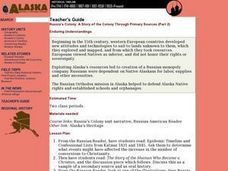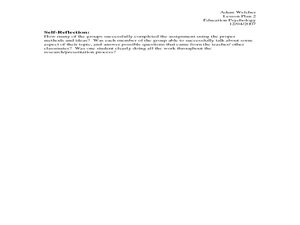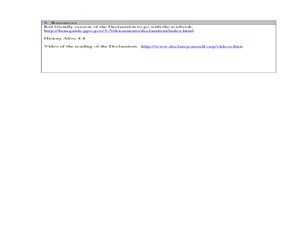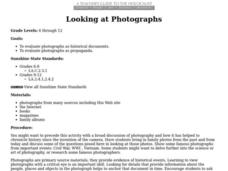New York City Department of Education
Colonial America and The American Revolution
How did the founding of the American colonies lead to a revolution? Use the essential question and sample activities to guide learners through a series of history lessons. Additionally, the packet includes effective strategies to...
Atlanta History Center
Civil Disobedience and the Atlanta Student Movement
What tactics are used in civil disobedience? Learners study the conditions in Alabama that led to the establishment of the Atlanta Student Movement, as well as consider the nature and effectiveness of civil disobedience.
US National Archives
WWII: The Atlantic 1939-45 – Battle of the Atlantic
The most dangerous line of attack during World War II wasn't the German planes soaring above Britain, but the U-Boats cutting off their supplies of food and equipment. Learners research the Battle of the Atlantic, the German campaign to...
National Endowment for the Humanities
The New Order for "Greater East Asia"
Sometimes the New Order becomes synonymous with its implications for European countries, but what about its consequences for East Asia? The final instructional activity in a four-part series teaches scholars about World War II. High...
US National Archives
The Home Front: How Did People Prepare for the War at Home?
Wars have a profound effect not only on a country's soldiers, but also on the everyday lives of its citizens. Invite young historians to discover how Britain prepared for the second World War by analyzing a series of government posters...
Annenberg Foundation
Analyzing Artifacts
If only a mask could talk! Using the interactive tool along with historical thinking skills, pupils uncover the meaning behind the various materials the resource presents. History becomes more relevant as the artifacts tell their stories...
Student Handouts
Letter from Christopher Columbus to Luis de Sant Angel Announcing His Discovery (1493)
When Christopher Columbus landed, he found many things to comment on. Have your class read this letter that he wrote to Luis de Sant Angel in 1493. The text is split up into sections. Each section is paired with two to three...
Jacaranda
First Australians
Here you'll find an extensive textbook chapter on Australia's indigenous people and the impact of European settlers on aboriginal tribes. The text includes several images, graphs, primary and secondary sources, follow-up questions, and a...
While They Watched
Teaching the Holocaust
What is the difference between prejudice and discrimination? Between collaborators and bystanders? Guilt and responsibility? Prompt learners to think critically about a very complex and textured topic with an innovative packet of materials.
Curated OER
Library of Congress Learning Page: The Historian's Sources Lesson Overview
Students study techniques for analyzing primary sources. Finally, students apply these techniques to analyze documents about slavery in the United States.
Curated OER
Russia's Colony: A Story of the Colony Through Primary Sources (Part 1)
Students review the Russian American Timeline connected to the Russia's Colony unit narrative.
Curated OER
Russia's Colony: A Story of the Colony Through Primary Sources
Students read "Epidemic Timeline and Confessional Lists from Katmai 1831 and 1845." They construct a picture of life in Alaska during the Russian period.
Curated OER
Primary and Secondary source Indiana event activity
Students research facts about Indiana's history. In this state history lesson plan, students use primary and secondary sources to research significant events from Indiana's history. They work in small groups to create a class presentation.
Curated OER
Language Arts: Gathering the Appropriate Information
High schoolers are able to use the library and/or computer lab to research reliable information sources supporting arguments being put forward in the position paper. They are able to find examples of mission statements from various...
Curated OER
From Smithson to Smithsonian: Who Was James Smithson?
Students evaluate and examine primary and secondary source material as they relate to the life of James Smithson.In this "From Smithson to Smithsonian" lesson, students analyze documents looking for clues to the identity of James Smithson.
Curated OER
Thomas Jefferson's Library: Making the Case for a National Library
Students examine the need for a national library. In this Library of Congress lesson, students analyze primary sources to investigate the persuasive techniques that Thomas Jefferson used in a letter meant to show his support of the...
Curated OER
South Carolina: Loyalist or Patriot?
Eighth graders examine the battle waged in South Carolina over the American Revolution. In this American Revolution instructional activity, 8th graders analyze primary sources as they determine how the Loyalists and Patriots chose sides...
Curated OER
Political and Cultural Road to the American Revolution
Learners examine the Declaration of Independence. For this Revolutionary War lesson, students use primary sources to analyze how the creation of the Declaration of Independence lead to the development of the United States as an...
Curated OER
Why War? Causes of the American Revolution and South Carolina's Role
Eighth graders investigate the role of South Carolina in the American Revolution. In this colonial American lesson, 8th graders analyze primary documents and images to determine how the state was involved in the outbreak of the war and...
Stanford University
Reconstruction Structured Academic Controversy (SAC)
Young scholars debate whether African Americans were free during Reconstruction. In this debate instructional activity, students use primary documents to support their argument as to whether African American were free during the...
Curated OER
Looking at Photographs
Students evaluate photographs as historical documents and photographs as propaganda.
Curated OER
The 'Capital' of the World
Students are introduced to the purpose of the World Bank and its president Paul Wolfowitz. After reading an article, they work together to complete a writing exercise in which they use primary source documents to state their viewpoint. ...
Curated OER
African-Americans and the New Deal's Civilian Conservation Corps
Students discover the responsibilities of the Civilian Conservation Corps. In this New Deal activity, students analyze the impact that the inclusion of African Americans in the Civilian Conservation Corps made on race relations in the...
Curated OER
Revolutionary Women of South Carolina
Students examine multiple primary sources. In this revolutionary war lesson, students read case studies regarding women from South Carolina. Students will compare the different roles women played during the Revolutionary War. Students...

























